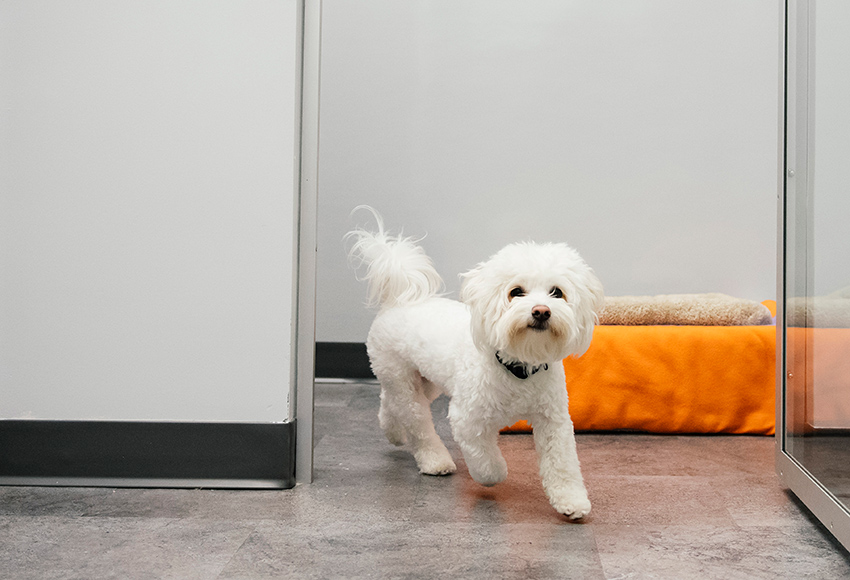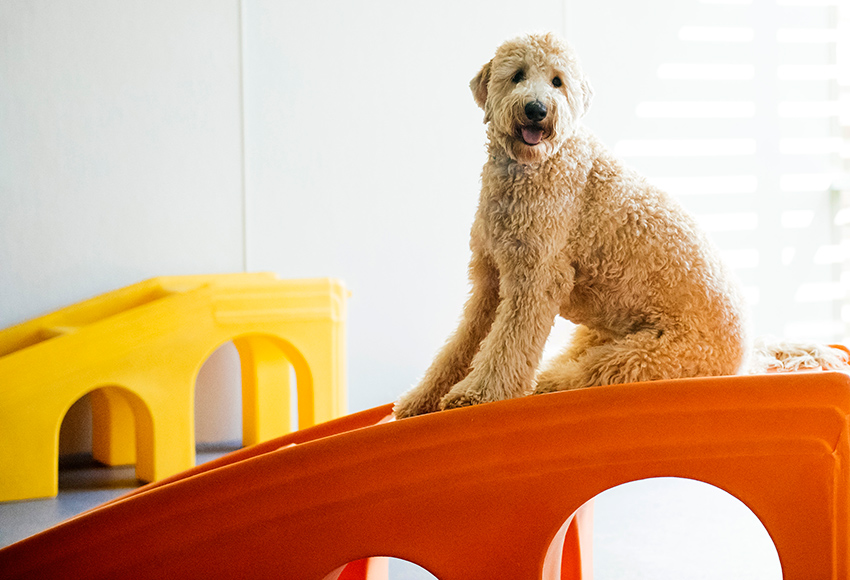Understanding Dog Behavior

“Is my dog playing or being aggressive?”
Dogs love to play, and it’s a great way for them to explore the world and learn how to socialize with other animals and people. Roughhousing is just part of the fun and in most cases, it’s completely healthy, safe and harmless. However, sometimes it can become dangerous if a pup takes it too far. It’s totally normal for dogs to pay-bite, bark, chase, swipe, and lunge, as long as it’s in a gentle and friendly manner. But sometimes growling, biting, jumping, barking, etc. can shift from playful to aggressive. Our canine coaches complete more than 100 hours of training from a custom curriculum designed by a registered canine behaviorist. They become experts on recognizing signs of aggression and learn how to de-escalate aggressive play. As a pet parent, it’s extremely important that you are able to identify the signs of aggressive behavior, too!
What Influences Aggressive Behavior?
- Learned Behavior – if a dog displays aggression and the thing they were scared of goes away, the behavior may have been reinforced and will most likely happen again.
- Social Development – dogs who were isolated growing up are more likely to show aggression than dogs who were well-socialized.
- Stress and Fear – dogs are more likely to show aggression when they are under stress or scared. Hormones – elevated levels of testosterone may manifest as aggression in dogs. Females in breeding season or with litters may demonstrate more aggression.
Signs of Aggression
Aggressive play can appear in a variety of different ways. Just because a dog displays some aggressive behavior, does not mean the dog should be labelled an aggressive dog. There are actually aggressive displays that are appropriate for some situations. For example, a mother pup growling at her puppy for pulling on her tail is appropriate aggression. However, if she bit and hurt the puppy, it would not be appropriate. It’s important to be able to tell the difference and recognize when you need to intervene to prevent the behavior from escalating.
When dogs play, it often takes the form of play fighting, play biting and wrestling. Although it can be fun and harmless, sometimes this can intensify into unsafe and serious scraps if you do not observe your dog closely. If you encounter an aggressive moment between dogs, it’s often not enough to let them work it out on their own. It’s better to keep the pups safe and intervene, rather than letting the dogs continue to engage in a potentially dangerous situation. It’s also important to remember redirected aggression can occur. When a dog displays aggression, although it may be directed at another animal, they can become frustrated and redirect their hostility towards you, another animal, or another person nearby.
When to Intervene
To prevent playing turning into fighting, it’s important to watch carefully for stress signals and warning signals. Some of the most common warning signals are:
- Stiffness – when a dog becomes tense and stressed, they usually appear rigid and stand in a stiff-legged stance. Their face is another indicator, so look for muscles tightening or furrowed brows.
- Freezing – when a dog becomes tense or rigid, they may enter a state of nervousness and freeze up.
- Direct Stare – another indicator of a stressed pup is when they intently focus on another dog without blinking or engage in excessive and aggressive stalking.
- Snarling – often ignored by humans, tiny muzzle movements associated with a lip snarl may be an indicator of an uncomfortable dog. Dogs will often lift their lip in a snarl before they growl or snap.
- Growling – sometimes dogs will growl during play (vocalizing), but these growls are accompanied with loose, relaxed body language. When growling is followed by any of the above behaviors, or is deep and low, it may be a sign of aggressive behavior that needs to be addressed.
How to Prevent Aggressive Behavior
To discourage aggressive behavior from your four-legged friend, introduce a solid training program and good socialization into their schedule. There are some basic steps that can be taken to decrease this behavior:
- Socialize Your Dog Early – schedule play dates with other puppies and well-mannered adult dogs who can teach your puppy how to behave.
- Neuter or Spay Your Dog – do this as early as possible, as it can help reduce hormone-driven aggression.
- Use Positive Reinforcement – treat your dog kindly and never intimidate or physically correct your pup.
- Supervise Your Dog At All Times – don’t leave dogs unattended where they can adopt inappropriate behaviors.
At Dogtopia we’re committed to 100% transparancy with our pet parents. Through our live HD webcams, you’ll be able to watch our highly trained Canine Coaches supervise the dogs in the playroom and actively monitor them for signs of aggressive behavior and escalated play. Instead of reprimanding dogs for unwanted behaviors, you’ll see our Canine Coaches redirecting them in a positive way by encouraging a new, safe activity. Plus, our Canine Coaches know how to keep a playroom engaged through activities like bubble parties and brain games as well as practicing helpful skills like door manners, bark control, and name recognition. You can trust that our passionate team prioritizes maintaining safe and happy playrooms where tails never stop wagging!





